Environment & Energy
Related: About this forumThe External Cost, Including Climate Cost, of Stationary Batteries For Grid and Off Grid Power.
Last edited Sun Feb 6, 2022, 10:44 PM - Edit history (1)
The paper from the primary scientific literature I'll discuss in this post is this one: Additional Emissions and Cost from Storing Electricity in Stationary Battery Systems (Schmidt et al Environ. Sci. Technol., 2019, 53 (7), pp 3379–3390)
My first exposure to the concept of life cycle analysis was when, years back, the European Union released it first ExternE reports, which attempted, in units of Euros, to monetize the destruction caused by the use of energy, that is the external costs, the cost of destroyed human health, destruction to the environment including but not limited to climate change, and the depletion of resources.
The figures in the early report showed - and this certainly caught my attention as my enthusiasm for nuclear energy, while firmly established, was accelerating at the time, even though, back then, I was still a fan of so called "renewable energy," - that the external costs of nuclear energy were the lowest calculated by the use of the variables then in use.
Ten or twelve years later, the general ExternE concept has exploded in the scientific literature, and now comes under the general rubic of "Life Cycle Analysis" often abbreviated "LCA."
If one puts the search terms LCA and Life and cycle in Google scholar, one will get about 179,000 hits, in 2019, over 3,400 as of this writing.
Many examples of software to calculate these costs in various units, for example, grams of CO2 per kWh for electricity generation by various means, or 2,4 dichlorobenzene equivalent for toxicological effects, and yes, in terms of money, dollars, euros, whatever. There is for instance, Ecosense, which appears regularly in the scientific literature but there are many, many other such programs.. No one person can possibly read all of the papers written on this subject, of course, but personally, I have come across perhaps a thousand or so over the years.
One needs to realize that these calculations contain a great deal of subjectivity, because intrinsically many questions connected with values arise.
To wit:
There are right now, said to be 849 whooping cranes left on this planet as of this writing. This is way up from the number a few decades ago, which was 21. The whooping crane is a very photogenic animal, quite beautiful:
 ?crop=2077,1180,x0,y15?width=1200
?crop=2077,1180,x0,y15?width=1200
The bird has the largest wing span of any North American Bird. Whooping Cranes, when released in the wild, migrate from the Gulf of Mexico to Northern Canada each year.
There was a time in my life, a few decades ago, when people who self defined as "environmentalists" cared more about the whooping crane than about, for example, Elon Musk's stupid car for millionaires and billionaires.
Sigh...
Here is the whooping cranes' migratory pathway:
 ?resize=630%2C353
?resize=630%2C353
Notice that it goes right through Oklahoma and Oklahoma, those oil and gas drilling hell holes that votes repeatedly for ignorant rednecks to be their Senators, including the oblivious fool James Inhofe, one of the most prominent climate change denying assholes in the United States Senate, the US Senate being an organization that has degenerated into a club of morons controlled by the silly, cartoonish, Pravda wannabe channel propaganda channel, Fox News.
Of course, in modern times, we do have people who call themselves "environmentalists" who slobber all over Oklahoma with their ignorant "percent talk," since as a state, Oklahoma has one of the highest percentages of electricity produced by wind energy, which was, as of 2017, according to the EIA, 32%. Of course, this also means that the bulk of the electricity is not produced using wind energy.
This reminds me of one of my favorite engineering jokes: “ The optimist says the glass is half full; the pessimist says it's half empty, and the engineer says the glass is twice the size it needs to be.” Call me a pessimist, but I note that it is possible for the 68% of electricity not produced by wind to actually be greater than the zero percent case that applied in the case that overall consumption has grown to more than 147% = 100%/.68 of what it was a few years early. It is possible in percent case a system to be losing ground. This is, in fact, what is happening on the entire planet. All the so called "renewable energy" assembled after decades of mindless cheering, is not even close, not even remotely close, to matching the increases in overall energy consumption world wide.
Anyway, let's indulge in some "percent talk" with respect to Whooping Crane populations There are seven billion human beings on this planet, and it is a fact that this is way past the carrying capacity of the planet. If one whooping crane is killed by a wind turbine blade in Texas, it would represent roughly 0.12% - we all love percent - of the population, and would be in percentage terms the equivalent of killing 8,400,000 human beings. If another Whooping Crane is killed by a wind turbine blade in Oklahoma, that would be the equivalent of killing 16,800,000 human beings. If a third is killed in Kansas by a wind turbine blade, it would be the equivalent of killing 25,200,000 human beings, and so on through Nebraska, South Dakota, North Dakota, Manitoba, Saskatchewan, and Alberta.
We accept the deaths, year after year, decade after decade, the deaths of tens of millions of people – in this century we have accepted the death over 130 million people, almost twice the population of the United Kingdom – from air pollution without so much as a whimper, although many, many, many people refuse to accept Fukushima, thinking that it was more or less, the worst energy disaster of all time.
But in a purely scientific sense, the deaths of 130 million people will not have as much of an effect on the human population as the death of one whooping crane will have on the whooping crane population. Species that have suffered but survived a near extinction – cheetahs are well known example – have lost considerable genetic diversity, and the population as a whole, may lose genes that may prove critically important to survival as a result, for example, of extreme weather events. At one point, again, there were only 21 whooping cranes, and environmentalists of another time – a time when environmentalism involved more than platitudes about electric cars, solar cells and industrial wind parks that people imagine, albeit with considerable delusion, will make their consumer lifestyles “sustainable” - cared more about whooping cranes than wind turbines. Those historic environmentalists worked hard to get the population closer to 1000 than to 10.
(There is a nice open sourced overview of the genetic diversity of endangered species for interested "old school" environmentalists, discussing the utilization of modern "-omics" technologies such as gene sequencing: Conservation of adaptive potential and functional diversity: integrating old and new approaches(able, B.K. Conserv Genet (2019) 20: 89. https://doi.org/10.1007/s10592-018-1129-9))
The reason for this long riff about whooping cranes is that while some LCA analyses include the economic costs of human health and human loss of life, for example in DALY, (Disability Adjusted Life Years), as if we knew what a human being is “worth,” I don’t believe there are any which consider anything life the value of a species, whether the species in question is photogenic, like polar bears and whooping cranes and butterflies, or an ugly insect eating bat like the endangered Ozark Big Eared Bat (Corynorhinus townsendii ingens).
While LCA’s are valuable tools, one must be aware that the relative importance of any factor factors depends very much on one’s values.
By the way, in 2017, Oklahoma consumed, according to the full data tables that can be accessed here, 73,731,764 MWh of electricity. (I have alluded to one of these tables above, and will take much data below from one of these spreadsheet tables.) This represents an average continuous power of 8,400 MW.
In order to provide this much electricity (assuming 33% thermodynamic efficiency, although higher efficiencies are accessible), one would need to consume about 0.332 grams of plutonium per second, this while providing no threat to whooping cranes, or for that matter, the lungs of human beings. This could be accomplished in 5 or 6 buildings or small complexes. In a year, this would involve the production of less than 11 tons of potentially very valuable fission products.
Nevertheless, despite the sense of the former paragraph, ignorant people who know absolutely zero about plutonium but fear and hate it all the same, would rather fill tens of thousands of acres laced with bird and bat grinders - and maintenance and construction access roads - involving literally tens of thousands of tons of steel, aluminum, and huge quantities of exotic elements, all of which will require redundant systems because the wind does not always blow in Oklahoma or anywhere else.
Right now, and for the immediate future on a planet where the carbon dioxide atmosphere has risen to roughly 413 ppm, as compared to 371 ppm in April of 2000, the redundant system to back up the wind crap is dangerous natural gas and coal plants.
A capacity factor is the ratio of the energy actually produced to the nameplate capacity operating 100% of the time. One of the big lies told by people making excuses for the so called "renewable energy" industry's failure to address climate change, is to report peak power, in units of Watts, for so called "renewable energy" installations that might operate at 20% of capacity as if were the same as nuclear plants, most of which operate at close to 100% of capacity.
The 2017 capacity factors for wind turbines in Oklahoma ranged from 19.4% (August 2017) to 49.1% (March 2019). Overall the capacity utilization of wind power in Oklahoma was 40.3%, which, by the way, is very high compared to most wind systems on this planet. Oklahoma must be a windy place. I can't remember; it's been a long time since I was in that state. Nevertheless, the available electricity for these turbines had nothing whatsoever to do with demand. The average high temperature in August in Oklahoma City is 93F. Presumably people turn on their air conditioners. In August of 2017, the capacity utilization of combined cycle dangerous natural gas plants was 63.1%; in July 71.2%. The waste from these plants was dumped directly into the planetary atmosphere.
The average monthly capacity utilization for dangerous fossil fueled power plants in Oklahoma was below 50%. The capacity utilization of coal plants in Oklahoma was extraordinarily low for coal plants in general, 45.3%, for combined cycle gas plants, 46.0%. This means that these plants most of the time were stranded assets, thus degrading their economic performance. I personally couldn't care less, since I oppose all coal plants and all gas plants and diesel plants.
The same people who want to cover thousands upon thousands upon thousands of acres of the Whooping Crane migratory pathway with wind turbines will engage in every more cockamamie schemes to make this useless crap work, and they claim, without consideration of the possibility of long wind droughts lasting weeks, or maybe months that huge batteries will save the day.
This, finally, brings me to the subject of the paper referenced at the beginning of this post, the carbon cost (and other external costs) of batteries. I really enjoyed this paper because it looks at batteries on a deeper level than one usually sees, accounting for the types of batteries as represented by their chemistry, their geography, and - this is very important, I think - the purpose for which they are used. The fact that the first two sentences in this very fine paper are nonsensical statements of the popular imagination that are in fact urban myths rather than representations of reality has no bearing in my mind on the paper's quality.
These two sentences are:
Renewable energy technologies are not playing a "key role" in decarbonizing the electricity sector, which is by the way not being decarbonized. After half a century of highly inflated rhetoric about how wonderful so called "renewable energy" is, or more regularly could be, the solar, wind, geothermal and wave industries combined produced, in 2017, 10.83 exajoules of energy as compared to 584.98 exajoules of energy generated and consumed by humanity. Between 2016 and 2017, the output of all the world's wind, solar, geothermal and wave powered plants combined grew by 1.21 exajoules, compared to the growth in energy consumption (from all sources) of 8.88 exajoules. (Ref: IEA 2017 World Energy Outlook, Table 2.2 page 79 and 2018 Edition of the World Energy Outlook Table 1.1 Page 38. (I have converted MTOE in the original tables to the SI unit exajoules in this texts.)).
"Could" is a word used, with obvious contempt for all future generations, by the advocates of and apologists for the grotesquely failed so called "renewable energy" industry quite often. The use of the word "can" in the second sentence of this otherwise fine paper is dubious, since it has never been proved that so called "renewable energy" can do anything to reduce the carbon footprint of energy. In fact, the opposite is true on inspection, until the dawn of the 19th century, all of humanity almost exclusively survived on so called "renewable energy," but abandoned it, because most human beings, even more so than today, lived short miserable lives of dire poverty.
The remainder of the first paragraph of the paper gets a little more realistic:
The next paragraph includes reference some, but not all, of the criticisms that I make of people wanted to bet the planetary atmosphere on this cockamamie scheme to convert all of our ecosystems into industrial parks to produce so called "renewable energy" as well as a statement of the raison d’être of the paper:
With reference to the phrase "potentially displacing cleaner generation" many advocates of and apologists for the so called "renewable energy" industry attack nuclear energy, as opposed to dangerous fossil fuels, even though dangerous fossil fuel waste kills millions upon millions of people continuously and is the major cause of climate change, and nuclear energy, um, does neither. The so called "renewable energy" industry will never be as clean, as sustainable, as safe as the nuclear industry. This is not to say that nuclear energy is risk free; clearly it isn't. As I often say, however, the nuclear industry does not need to be risk free to be vastly superior to all other alternatives. It only has to be vastly superior to all other alternatives, which, by the way, it is. In this country, because of these appeals to selective attention, wishful thinking and pure ignorance a process of replacing nuclear plants with dangerous natural gas plants is well underway, with this selfish generation dumping all the external costs on all future generations.
More raison d’être for the paper:
Figure 1, on system boundaries:
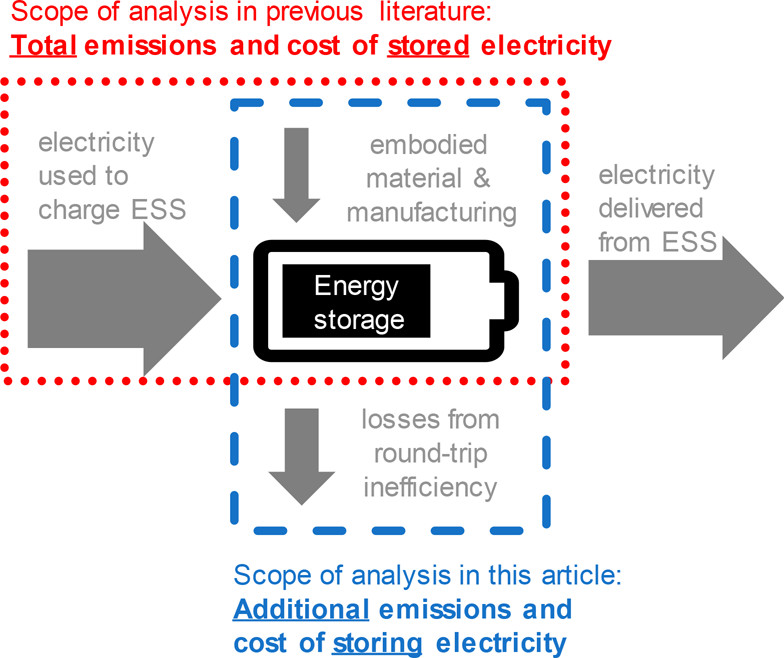
The caption:
This fine paper contains lots of abbreviations defined internally. Here is a description giving the abbreviations for types of battery chemistry explored in the paper:
The "gap" to which this text refers is that most papers focus exclusively on carbon dioxide external costs while not considering economics and the effects of geography, since as should be obvious from the fact stated above about the higher than usual capacity utilization of wind turbines in Oklahoma, more than 10% higher than that in Denmark, the wind does not blow with the same intensity or regularity every where, nor, although solar is even more trivial than the trivial wind industry, is the insolation the same everywhere: In some places it rains often or snows often; in other places this is less of a factor.
Other abbreviations in the paper refer to how the batteries would be or are used, which is also a very different factor. An interested reader if there is an interested reader can access the open sourced supporting information of the paper to get a detailed description of the types of use abbreviated. That supplementary material is here: Supporting Information
The abbreviations for types of use are these: WA, wholesale arbitrage, AF, area and frequency regulation, TD T&D, upgrade deferral grid, PS demand peak shaving commercial and industrial, SC increase of self-consumption residential end consumer. Again, the details of what these usage types are is in the supporting information.
Science is a mathematical enterprise, and here are some types of simple calculations that the paper utilizes:

...and...

where LCEbat is the manufacturing phase emissions for battery production, including all necessary replacements during a 20- year lifetime (CO2e/battery system), LCEel,charged is the lifecycle emissions of charged electricity (CO2e/kWh), kWhapp is the annual electricity delivered from battery (kWh/year), lifetime denotes the lifetime of the battery system (years), held constant at 20 years, and ? is the roundtrip efficiency of battery system (%). Please note that emissions related to the end-oflife phase are not considered in eq 2 because our analysis does not cover them, given the lack of available data.
The sections that I have put in bold by me and not in bold in the original paper refer to two points that I often make:
The first point is that the second law of thermodynamics - a law that is not subject to repeal by Edward Markey's so called "Green New Deal" which is not even close to being "green," since so called "renewable energy" is not sustainable nor can it be effective at addressing climate change (I say this as a lifelong Democrat) - is that storing energy wastes energy irrespective of the fact that advocates and apologists for the so called "renewable energy" also prattle on about energy efficiency with absolutely no appreciation of Jevon's paradox. Jevon's composed his paradox, by the way, at the time that the world was abandoning "renewable energy" to displace it with a "new" wonder fuel that he was contemplating: coal.
The second point is that the vast amounts of materials that support the so called "renewable energy" fantasy will become waste when the renewable energy facilities are no longer workable. Their observed and calculated lifetimes are incredibly short when compared to nuclear plants, even those built in the 1950's, like Britain's Calder Hall reactor, the first commercial nuclear nuclear reactor in the western world, a reactor built to put the "fear of God" into then regularly striking British coal miners. Appeal to the comprehensive Danish database of existing and decommissioned wind turbines gives a mean lifetime for this metal and concrete intensive technology of less than 18 years. Calder Hall ran for close to 50 years. Advocates and apologists for the so called "renewable energy" industry" engage in a lot of hand waving about recycling these vast quantities of matter, without even a remote understanding of the chemistry and environmental impact of recycling complex materials, of which batteries are merely a subset.
The current issue of Environmental Science and Technology from which this paper comes has two related papers, one on recycling batteries, and the other on the general limitations of LCA calculations, which do not include intangibles, like the existence of Whooping Cranes.
These are the two papers in question:
Upcycling of Spent Lithium Cobalt Oxide Cathodes from Discarded Lithium-Ion Batteries as Solid Lubricant Additive (Pol et al, Environ. Sci. Technol., 2019, 53 (7), pp 3757–3763)
...and...
Uncertainty Implications of Hybrid Approach in LCA: Precision versus Accuracy (Jessica Perkins and Sangwon Suh, Environ. Sci. Technol., 2019, 53 (7), pp 3681–3688)
From the first of these two papers, some text:
... Zhang5,6 X. et al. showed that trichloroacetic acid (TCA) and trifluoroacetic acid (TFA) along with hydrogen peroxide reductant can leach lithium and cobalt up to 90%. Yao L. et al. used D,L malic acid7 as a leaching agent as well as a chelating agent to recycle LiNi1/3Co1/3Mn1/3O2 (LNCMO, different type of cathode material). Santana I. L. et al. used citric acid8 as a leaching agent with enhanced recovery. To achieve higher metal recovery, Jie G. et al. used iron powder9 to reduce LCO first followed by acid leaching, which eliminated the use of peroxide. Furthermore, they enhanced the yield of valuable metals by optimizing the ball milling parameters...10
...Though these methods show fascinating results, it is very difficult to implement such ideas commercially, especially due to the high cost of leaching agents, waste generated, and purification requirements after use. Additionally, the secondary product, i.e., recovered LCO, requires enrichment of lithium to achieve a comparable battery performance as that of pristine LCO...
By the way, the moral cost of cobalt is not included in LCA calculations. My son bought me an interesting but painful to read book on the subject of human slavery in the United States, this one: The Half Has Never Been Told which argues that modern American wealth as well as historical American wealth derives from its unbelievably sordid history of human slavery. It's a compelling thesis. Modern lithium batteries also depend on slavery, modern African slavery in the Congo, because the largest fraction of the world's cobalt is obtained by using enslaved children as miners. This is the issue known as the Coltan crisis.
And no, recycling will not make that moral cost go away. Cobalt is a monoisotopic element. There is no way to trace its source, and in any case, for things like Elon Musk's magical car for billionaires and millionaires, we require more cobalt than that which has already been mined.
Some more math, touching on the non-inclusion of magical recycling techniques:

where CAPEX is the capital expenditures (EUR), OPEX is the operation and maintenance expenditures (EUR), kWhapp is the electricity delivered as defined by application (kWh), r is the financing cost (%), and T is the battery system lifetime (years). Here, we neither consider end-of-life cost (e.g., for recycling) nor any scrap value.
It is important to note that simply comparing LCC does not take into account that the value of storage differs among applications. Therefore, LCC should not serve as the only metric for making investment decisions...
The all important thermodynamics of energy storage which would make so called "renewable energy" even less efficient than its already pathetic efficiency and production:

where ceff is costs incurred from efficiency losses, kWhapp is electricity delivered as defined by application (kWh), ? is roundtrip efficiency (%), and pel is price of electricity for charging the battery system (EUR/kWh). Total OPEX are derived by summing up fixed annual OPEX (see SI Table S4) and ceff.
At this point, it's probably worth it to look at the pictures. Before doing so, for reference, it is useful to keep figures in one's head for the carbon cost of the major forms of fuel on this planet used to generate electricity, which are the three dangerous fossil fuels, coal, gas, petroleum, nuclear and hydroelectricity. All of these generate more than 20 exajoules of energy per year. In this context, it is also worthwhile to consider the working figures for trivial forms of electrical energy generation, solar and wind. The figures vary widely, depending on where you read, but I'm going to use the figures from a paper written some time ago in a paper written by Paul Denholm, now at the National Renewable Energy Laboratory and coauthors in 2005 - I don't expect the figures will have changed much in the intervening years with respect to carbon dioxide. For coal he claims (900-1100 grams CO2 per kwh), combined cycle gas (400-500 grams CO2 per kWh) - he doesn't give figures for pure thermal gas, which are undoubtedly higher - for nuclear, 10-25 g CO2 per kWh and wind (no storage) 5-25 grams/kWh.
Denholm's paper is here: Emissions and Energy Efficiency Assessment of Baseload Wind Energy Systems (Denholm et al, Environ. Sci. Technol., 2005, 39 (6), pp 1903–1911.
With the exception of wind energy, which obviously depends on where the wind facility is located - a facility destroying thousands of acres in windy Oklahoma will be very different than an industrial wind park trashing the continental shelf offshore in New Jersey, these figures seem consistent with the many, many, many LCA papers I've come across. Denholm was writing about the environmental cost of storing wind energy using compressed air, assisted by dangerous natural gas to recover thermal losses from the cooling from gas expansion; he considered it would raise the carbon dioxide cost of wind energy to somewhere between 69-102 g CO2/kWh for the 5 types of turbines he and his coauthors considered.
In Denholm's paper, he was assuming that the wind turbines were in the American Midwest, and Oklahoma, with it's unusually high capacity utilization probably qualifies for what he may have been thinking. By the way, in the 15 years since his paper was written, the number of huge scale air compression energy storage facilities powered by the wind is essentially zero.
The carbon cost of solar facilities is also highly dependent on location, for example, if the solar cells are located on a roof in Phoenix, or if they are covered for weeks or months at a time by snow in Vermont. I don't think that people really appreciate the metal intensity of so called "renewable energy," even solar energy.
An overview of metals used in the solar industry, the other form of energy that is supposed to charge millions and millions of large scale batteries can be found in a paper by a scientist at PV Environmental Research Centera Brookhaven National Laboratory who writes quite a bit on the external costs of solar energy, Vasilis Fthenakis.
It is here: Life cycle inventory analysis of the production of metals used in photovoltaics (Fthenakis, Wang and Kim, Renewable and Sustainable Energy Reviews 13 (2009) 493–517)
For our 100% renewable "by 2050" or "by 2035" or "by 2100" and "by [insert year after you'll be dead]" I offer the following text excerpts from that paper:
...Teck Cominco Ltd. is one of the world’s largest indium producers, generating approximately 36 tonnes of high-purity (99.998% and 99.9999%) indium per year. It recovers indium from gaseous streams at its integrated zinc and lead in Trail, British Columbia, Canada. Fumes and other particulates from the lead smelter are transferred to the zinc facilities for hydrometallurgical separation and from there to the high-purity indium plant. Fumes generally contain only 0.05–0.2% In or Ge. The plants then leach the fumes to extract In and Ge into solution (along with Zn and Cd) to separate them from the lead sulfate residue. After a first leaching, slurry is settled to remove a lead oxide residue which is pumped back into the lead smelter, and the clear solution is passed on to a second leach. There, the slurry is partially neutralized with direct fume addition and ferric iron to precipitate germanium, indium, arsenic and antimony. This precipitate is the feed for the indium/ germanium recovery plant. The residues from the oxide leaching plant second leach are re-leached with sulfuric acid to dissolve the contained germanium and indium. After filtration, the clear solution is processed in a solvent extraction (SX) unit where both metals are recovered and subsequently reprecipitated to a product for further purification...
Two graphics from Renewable and Sustainable Energy Reviews 13 (2009) 493–517):

The caption:

The caption:
I'm sure all of these pyrometallurgical retorts in Canada will do just fine, powered by the wind, perhaps with compressed air storage, or maybe not.
Nevertheless, even with some knowledge of the steel requirements for wind turbines, the aluminum requirements for wind turbines I will buy the 10-25 g/kWh for CO2 for wind energy, and include solar energy along with it [b]at least when they operate. The elephant on the table is that these forms of energy require back up, and an honest appraisal would assess the economic and environmental costs of back up and include it in their real costs .
My opinion is that there is very little honesty among those who have bet the atmosphere on this cockamamie scheme that was abandoned close to 200 years ago, making energy dependent on the weather, but again, that's my opinion, and one is free to question whether I know as much as someone who, for example, cruises university press releases to announce "breakthroughs" that assure us that it was the right thing to bet the planet, and much of the life on it, on the success of so called "renewable energy."
Now let's return to the original paper cited at the outset here which discusses the added costs in CO2 and money for storage of energy using batteries.
In the following graphics showing the results of the battery analysis, note that the units on the ordinate for carbon dioxide are in kg/kWh and need to be multiplied by 1000 to convert to [grams/kWh as cited above and in many other LCA papers.
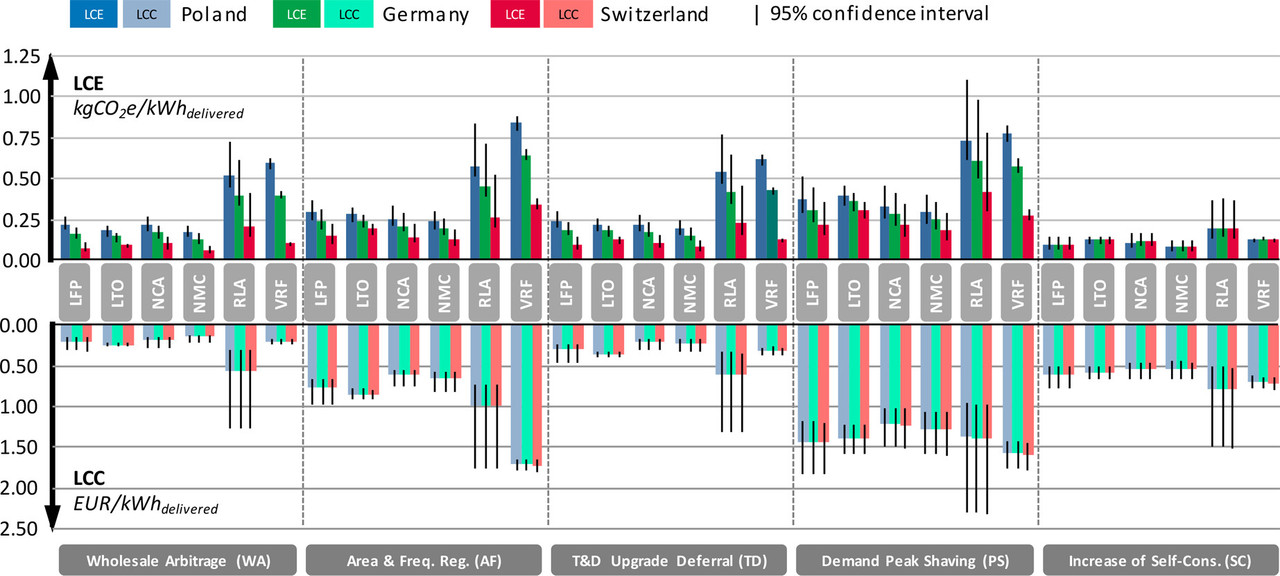
The caption:
In all usage cases, the lithium based batteries perform better than the lead based batteries and the vanadium based batteries; in Poland these two types of batteries is some use cases make the carbon dioxide cost actually greater than burning dangerous natural gas, and even approaching the case of coal. On the other hand in the arbitrage case in Switzerland, the "buy low, sell high" strategy - storing energy purchased at low busbar prices to sell it when busbar prices are high shows the best performance over all for carbon dioxide in Switzerland, nearly approaching the low carbon cost of nuclear plants, especially if one is willing to ignore the subsidy paid by slave laborers digging cobalt in the "Democratic" "Republic" of the Congo for three of the four lithium battery types.
I shouldn't, I know, keep dragging this slave labor thing into it all - Elon Musk is a hero - but well, I can't help it you see, because it bothers me just a little. Slave laborers in the "Democratic" "Republic" of the Congo aren't "green" like us; they're black. The Half Has Never Been Told.
All of the slave subsidized batteries perform pretty well in all scenarios, ranging (in exactly one case, in Switzerland for arbitrage, and in nearly all cases for the SC, "off grid" cases) from nearly nuclear equivalent to "only" 15X (1500% in "percent talk" ) higher than nuclear for carbon emissions, at least if one only looks at the batteries and not the intrinsic costs of the wind turbines and solar cells themselves. In the latter case, if one does include these costs, then they're only twice as high as nuclear.
To evaluate the consumer cost, whether the consumer is a large scale utility or some "off grid" homeowner, one should note that as of this writing, the Euro is worth about $1.12, and that US Electricity Prices, as of March 29, 2019, range from 8.8 cents per kWh in Oklahoma "where the wind comes sweeping down the plains" to 32.09 cents/kWh in Hawaii with the US average being 12.47 cents/kWh or 13.96 euro cents/kwh.
For the arbitrage people this doesn't matter, since they're buying electricity when it's cheaper than average, and selling it when it's higher than average. The "off grid" people are paying more than 300% more than US consumers, but they're very noble, at least if you don't count the slave labor subsidy, which I should stop bringing up, except "The Half Has Never Been Told."
This is probably the graphic that needed the most attention, I think, since it says the most. This is into what we are sinking the future of the world, and even if it's not working and won't work, well either read it and weep, or cheer, it matters not.
The breakdown of cost of manufacturing batteries in emissions only, slaves and resource depletion notwithstanding, and the losses of energy to the second law of thermodynamics:
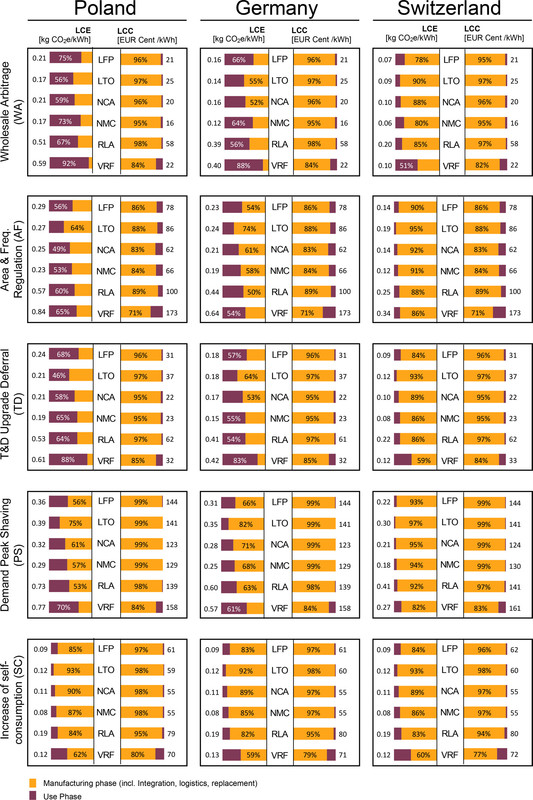
The caption:
Component based and process based carbon dioxide costs:

The caption:
A graphic designed as a summary.

The caption:
Don't worry, be happy. Even though batteries suck, we can always read press releases about how batteries can someday be better and put our hope in hope.
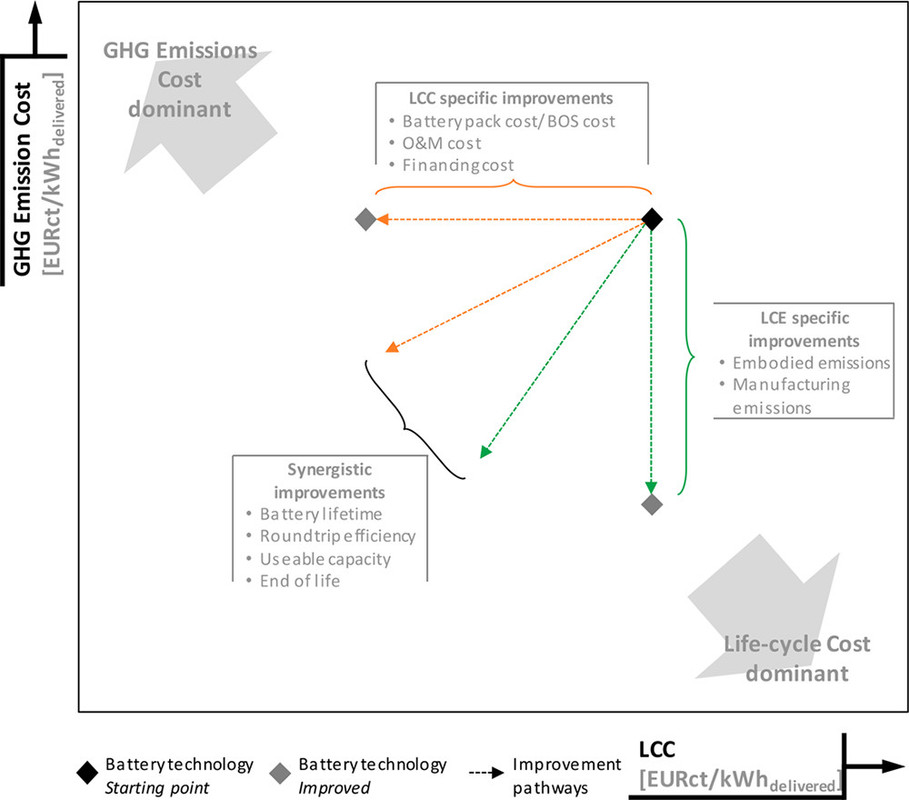
The caption:
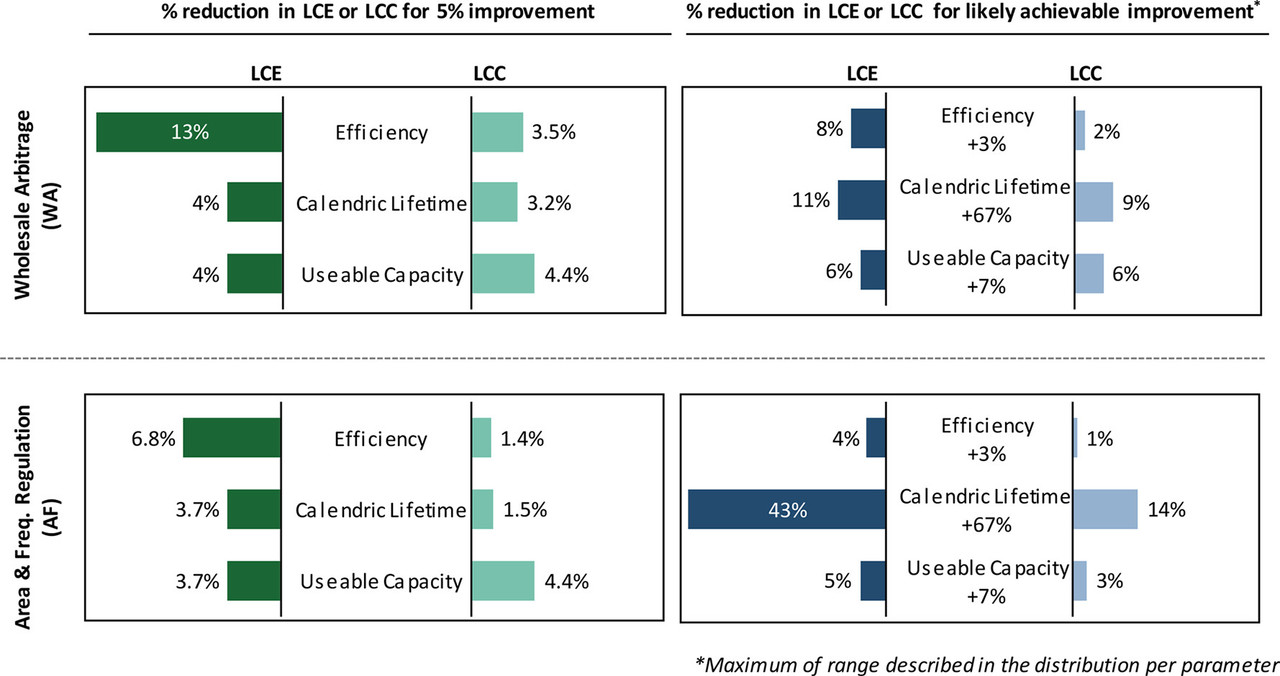
Where the authors think we should focus our efforts in the "don't worry, be happy" case to realize these improvements, even though climate change is here and now:
The caption:
From the author's conclusions:
I have bolded what the authors concede they have not discussed about our dreams of that grand renewable nirvana we burn gas and coal to praise so loudly and so often. They also didn't mention moral costs, but that's OK, I did, I couldn't help myself. The Half Has Never Been Told.
Above I remarked that it's quite possible that no one will read what I say, and fewer will care. The value of writing this long post was, for me, to clarify my thinking. Clear thinking can make one weep.
I hope you've had a pleasant weekend thus far, and will have a pleasant Sunday evening.
eppur_se_muova
(36,260 posts)production, which both center around deposits in central Africa. The social and political conditions are about the same for both, so what make one situation better or worse likely affects the other as well. But 'coltan' refers to the similar ores columbite & tantalite, sources of 'columbium', since renamed niobium, and tantalum. Both are used to make ultra-compact high-performance capacitors for digital phones and other consumer electronic devices where light weight demands premium materials, and the growth in demand for such devices has stoked the use of slave labor in central Africa, where by whatever geochemical contingency, most of the world's supply is found. By similar contingency (probably ascribable to an ancient pluton) central Africa also holds the majority of the world's available cobalt ore, which is mined together with copper and nickel ores. If there is a practical difference between the two, it is that the actual tonnage of cobalt consumed is 10-15 x the amount of niobium, with tantalum being even less than niobium, and that consumption is rapidly rising, now driven overwhelmingly by production of lithium batteries.
Perhaps it should be referred to as the "Congo Problem", since so many problems are tied to the DRC's failure to institute democratic reforms, whatever the economics.
NNadir
(33,513 posts)...elsewhere on the internet about it in connection with it's use in the LAMPRE nuclear reactor that operated at Los Alamos in the early 1960's, a type of reactor that I believe should be seriously reconsidered, given it's potential for in situ spontaneous separation from fission products.
It doesn't matter what the particular name of the ore is; Amnesty International refers to general conditions in Africa for mining metals, cobalt being at least as odious as tantalum or niobium/columbium.
I have suggested the use of tungsten/technetium alloys as substitutes. Tungsten contains trace levels of isotope 180, which in theory under these conditions would be transmuted to tantalum, but I very much doubt this could be significant. It is likely that historic or in use hafnium control rods contain tantalum after use, although again, not huge amounts.
The issue with cell phones is also very serious. I own one and it pains me; it's very unlikely I could do my job without one.
However a cell phone contains far less tantalum than a Tesla contains cobalt.
It is unfortunate that the half-life of zirconium-93 is so long; otherwise niobium would be available as a fission product. Whenever I consider a new material containing either tantalum, cobalt or niobium, I ask myself if there is an alternative.
The solubility of tungsten in liquid plutonium is low, as is the solubility of tantalum; tantalum was selected in the late 1950's because it was easier to machine than tungsten.
To make tungsten machinable required at that time rhenium as an alloying agent.
Ironically technetium is an excellent substitute for rhenium, and is easily more readily available, a point made in the old edition of Cotton and Wilkinson in my personal library. Technetium was available only in trace amounts in the 1950's, and was regarded as a waste product to be dumped in places like the Hanford tanks, which was I think tragic.
Until this day, 90% of the technetium papers one reads that are not about medical tracers are about ways to dump technetium.
Technetium is such a wonderful metal. I have this beautiful little Russian monograph translated into English by Isrealis in 1970 wherein a Russian scientist remarked, all those years ago, how stupid it was that technetium was thrown away.
A reactor fueled with liquid plutonium, a Pu/Np eutectic, a Pu/Fe eutectic - I'll leave the Pu/Ce/Co ternary eutectic out here - with tungsten/Tc barrier coatings would introduce some very interesting chemistry for recovery, since it would involve difficult Re/Tc separations from the transmutation of W into (more valuable) Re, along with small amounts of osmium and iridium. Given the difficulty of Nb/Ta and Zr/Hf separations because of the lanthanide contraction, this one would be fun indeed.
It happens that ReF7 exists, whereas TcF7 does not. ReF7 exhibits a significant vapor pressure, so this is a possible avenue of separation, should it ever be industrially required, something that would only happen well after I'm dead. Liquid plutonium is such a good idea that eventually it will come back, I think, should humanity survive with any modicum of sanity left, sanity becoming as rare as rhenium.